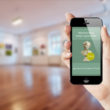Who Said Visiting a Museum Is a Boring Experience?
5971 Views
Do you worry about your patrons thinking that walking through exhibit after exhibit, reading descriptions of old stuff, makes them yawn? Would they rather park in front of the TV and tune into the latest Netflix movie than drive to your museum for the afternoon?
You are not alone if this concerns you.
With museum attendance falling off in the last several years, patrons need to be re-energized about the museum experience. Don’t try to make them put down their smartphones to enjoy your exhibits. Use their personal devices to your advantage by integrating them into the visit with beacon technology!
Proximity marketing featuring beacon technology is exploding on the scene around the globe, and it’s helping to disrupt what visitors take away from their museum, or other attraction, experiences.
How does beacon technology work?
Patrons are asked to download an attraction’s app either when they buy tickets online or at the door. The app then connects to the beacons that are placed throughout the exhibits. When the app comes into contact with a beacon, the visitor gets notified of unique information, or a chance to participate in various games or surveys.
Beacon technology coupled with the attraction’s app energizes patron visits in several ways:
It provides visitors a way to experience museums at their own pace.

Women and friend with beacon technology app at an exhibit in museum
Not every patron is going to be crazy about every exhibit. By using beacons with your exhibits, museums allow visitors the ability to control their time so they can experience it at their own pace, spend more time on the sections that interest them and less on the ones that don’t. There’s no waiting for a recording to stop explaining an exhibit that holds no interest in order to move on. When a visitor moves away from one beacon and in proximity to the next, the second one picks up and continues the museum’s story. This customizes and elevates the user experience, increasing the visitor’s positive experience.
It offers the ability to share “behind the scenes” exhibit information.
The digital world holds an unlimited amount of space, unlike the square footage of a physical attraction. Visitors can access additional information, fun stories, great music, and other relevant information tied to an exhibit, right on their smartphones. Museum planners can use beacon technology to create interesting information that could otherwise not be shared with their visitors due to space issues. This extra information and insight enriches the customer experience and transforms the visit into a more powerful, three-dimensional adventure.
Beacon technology eliminates the need for headphones.
Using traditional headphones supplied by a museum is a pain. Who wants to be grossed out by using headphones that dozens of other people have worn? In this day of germaphobia, those are NOT sublimely happy customer experiences.
Beacon technology partners up with each visitor’s smartphone. “Pings” from the beacon hit the guests’ phones They can interact with the information, click for more in-depth stories and history, listen to songs or first-person accounts, or anything else that is relevant to the exhibit. Instead of fighting with old, outdated headphones, visitors connect with the museum’s offerings and enjoy a smooth experience with a trusted piece of equipment they know how to use.
Create gamification and other interactive opportunities.
People are tuned into games on their smartphones. Remember how obsessed everyone was with Pokémon Go? Museums can take advantage of this trend with beacon technology. In addition to offering a completely immersive, customized customer experience, beacon technology in museums can be set up to interact with visitors using games.
Trivia about each exhibit is a fun way to engage patrons. Choosing the best picture that describes an exhibit is another popular idea museums can use gamification to benefit their guests’ visits. This type of interactive experience helps visitors own their experiences, and easily share them with friends across social media channels.
A side note: Museums benefit too!
An extra benefit gamification offers museums is that it gathers information on the attraction’s visitors. This data can answer important questions. Which of your exhibits ended up catching and holding the most attention? Which areas of the museum see the most traffic? How high was the participation rate in the game? These analytics are essential to increasing success. Museum decision makers can use their findings to create new exhibits, drive future attendance, and create a higher level of ongoing customer satisfaction.
The good news is that today’s museum experience doesn’t have to be boring. It can be interactive, immersive, and fun! By adding beacon technology strategically throughout the exhibits, patrons can guide their own visit and create their own unique experience. Best of all, they will share their newfound museum love with friends, family and on social media.
It’s time to disrupt the same old, traditional viewpoint by integrating beacon technology for museums!

